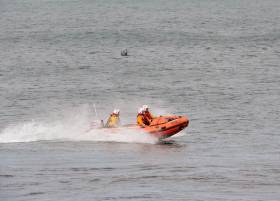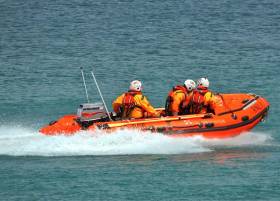Displaying items by tag: Silver Strand
#Rescue - A mother and her two children were rescued from a sea cave at Silver Strand yesterday afternoon (Saturday 29 July) in a joint operation between Wicklow RNLI and the Irish Coast Guard.
The two children had got into difficulty while swimming at the popular beach south of Wicklow Head, and their mother rushed to their aid – only for the three of them to be swept into a nearby cave.
Wicklow RNLI’s inshore lifeboat was launched at 4.40pm and arrived on scene with the Dublin-based coastguard helicopter Rescue 116, which lowered a winchman onto the beach to locate the casualties.
The Wicklow lifeboat followed shortly after, and helm Graham Fitzgerald brought the rescue vessel close to shore where the lifeboat crew spotted three people and the winchman in a cave.
Weather conditions in the area were windy, with a southerly Force 4 and high breaking surf at the mouth of the cave.
After an assessment by the winchman and lifeboat helm, it was decided that the winchman would lead the casualties to the adjoining cave, as rocks at the entrance would impede getting the boat close to shore.
Once the casualties were in the other cave, the lifeboat crew brought the boat onto the beach and all three were transferred to the lifeboat along with the coastguard winchman.
The mother and her two daughters were believed to have been on a day trip to the beach when they decided to go for a swim and one of them got into difficultly. Her sister had tried to help, but also got into trouble.
The mother then entered the water to help her daughters, which resulted in all three of them ending up in the cave.
The winchman, a trained paramedic, assessed the three casualties on the lifeboat and they were brought to Wicklow Harbour, where they were given hot drinks.
Wicklow RNLI were involved in a similar rescue at Silver Stand in 2014 when the lifeboat was called out to rescue a woman who had been swept into a cave after getting into difficulty swimming.
#RNLI - Wicklow RNLI’s inshore lifeboat was launched at 1.48pm on Saturday afternoon (24 June) after a member of the public reported a windsurfer in difficulty off Silver Strand, three miles south of Wicklow Harbour.
The lifeboat with three crew — helm Graham Fitzgerald, Vinne Mulvilhill and Connie O’Gara — was alongside the casualty seven minutes after launching. A local angling boat had also stood by the windsurfer until the lifeboat arrived.
The casualty was taken onto the lifeboat and assessed. He did not require any medical assistance and was landed safely back on Silver Strand a short time later.
Speaking after the callout, Wicklow RNLI lifeboat helm Graham Fitzgerald said: “We located the windsurfer about half a mile offshore. He had left the beach earlier but the wind dropped and he was unable to get back ashore.”






























































